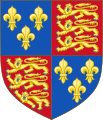Coat of arms of Scotland
| Royal Arms of Scotland | |
|---|---|
 | |
| Versions | |
 | |
 Banner of arms, which serves as the royal standard | |
 | |
In My Defens God Me Defend (abbr. In Defens) | |
| Use |
|
The coat of arms of Scotland, colloquially called the Lion Rampant, is the coat of arms historically used as arms of dominion by the monarchs of the Kingdom of Scotland, and later by monarchs of Great Britain and the United Kingdom. The coat of arms, or elements from it, are also used in heraldry to symbolise Scotland in general. The arms consist of a red lion surrounded by a red double border decorated with fleurs-de-lis, all on a gold background. The blazon, or heraldic description, is: Or a lion rampant Gules armed and langued Azure within a double tressure flory-counter-flory of the second.
The coat of arms was adopted in the 12th century by
The coat of arms rarely appears in isolation in royal or government contexts, as the arms of the United Kingdom are used instead. One exception is the
Description
The arms feature a red
The arms historically formed part of a full
Most of these elements were retained in the Scottish coat of arms after the Union of the Crowns, and in the Scottish versions of the coat sof arms of Great Britain and, later, the United Kingdom. Nevertheless, some changes were made: the sinister supporter was replaced with a crowned lion holding a banner bearing the flag of England, the dexter supporter now bears the flag of Scotland, and the coat of arms changed to reflect that used at the time.
History
Kingdom of Scotland



A form of these arms was first used by
Throughout the ages the arms passed from monarch to succeeding monarch with only slight variations in detail. In some early examples the lion holds a sword or wears a crown, and the royal tressure has sometimes been interpreted as an orle or bordure. Many of these relatively minor variations will have resulted from the individual efforts of stonemasons, weavers, artists and sculptors throughout the ages in their attempts to create a facsimile of the arms of the period, as well as mistakes and misinterpretations on the part of foreign heraldic artists.
Until the reign of James I (1406–1437) the Scottish monarchs did not use supporters; James introduced two lion supporters to the depiction of the arms on his privy seal and used a single unicorn elsewhere. The lions continued to be used almost continuously until the Union of the Crowns, the exception being James V, who used two unicorns on his privy seal. His daughter, Mary, Queen of Scots, reverted to the lions but used two unicorns on her great seal, the first monarch to do so. When her son, James VI, inherited the kingdoms of England and Ireland he began using one unicorn and one lion supporter, a practice continued to the present day.[2]
In the reign of James III, the Scottish Parliament made a curious attempt to get rid of the royal tressure, passing an act stating that "the King, with the advice of the three Estates ordained that in time to come there should be no double tressure about his arms, but that he should bear whole arms of the lion without any more". This state of affairs does not appear to have lasted very long, with James III soon re-instating the royal tressure, first without its top, and then in its original form.[3]
Upon the creation of the Public Register of All Arms and Bearings in Scotland in 1672 Charles II registered the blazon of the achievement of the King of Scots as:
"Or, a Lyon rampant gules armed and langued azure within a double tressur flowered and counter-flowered with flowers de lis of the second, Encircled with the order of Scotland the same being composed of Rue and thistles having the Image of St. Andrew with his crosse on his brest y unto pendent. Above the shield ane Helment answerable to his Majesties high qualitie and jurisdiction with a mantle or doubled ermine adorned with ane Imperiall Crowne beautified with crosses pattee and flowers de lis surmounted on the top for his Majesties Crest of a Lyon sejant full faced gules crowned or holding in his dexter paw a naked sword proper and in the sinister a Scepter both erected paleways supported be two Unicornes Argent crowned with Imperiall and goarged with open Crownes, to the last chains affixed passing betwixt their fore leggs and reflexed over their backs or, he on the dexter imbracing and bearing up a banner of cloath of gold charged with the Royall Armes of Scotland and he on the sinister another Banner azure charged with a St Andrews Crosse argent, both standing on ane compartment placed underneath from which issue thistles one towards each side of the escutcheon, and for his Majisties Royall Motto's in ane escroll over all In defence, and under on the table of the compartment Nemo me impune Lacessit."[4]
Kingdom of France

When
Following the death of Francis in 1560, Mary continued to use the arms showing Scotland and France impaled, (with a minor alteration of the arms to reflect her change of status from queen-consort to
Union of the Crowns
| Royal coat of arms of Scotland | |
|---|---|
James VI from 1603 as both the King of Scots and as King James I of England, France, and Ireland. | |
In My Defens God Me Defend (abbr. In Defens) | |
| Order(s) | The Most Ancient and Most Noble Order of the Thistle. (Arms feature the collar of the order) |
On the death of Queen Elizabeth I of England in 1603,
During the reign of
The addition by King Charles of Nemo me impune lacessit ensured that the
From the accession of the
Changes to the blazon of the arms
- Following the marriage of Mary, Queen of Scots, in 1558, the blazon of the royal arms of Scotland included elements from the arms of:
- The Dauphin of France, (1558–1559)
- The Kingdom of England, (1558-1560)
- The Kingdom of France, (1559–1565)
- Following the Union of the Crowns in 1603, the blazon of the royal arms of Scotland included elements from the arms of:
- The Kingdom of France, (1603–1707)
- The Kingdom of England, (1603–1707)
- The Kingdom of Ireland, (1603–1707)
- Following the reign of Charles II, King of Scots, the blazon of the royal arms of Scotland included upon a blue scroll overlying the compartment, the motto of The Most Ancient and Most Noble Order of the Thistle; Nemo me impune lacessit, and elements from the arms of:
- The House of Orange-Nassau, (1689–1702)
- Following the Acts of Union of 1707, the blazon of the royal arms of Great Britain used in Scotland included elements from the arms of:
- The Kingdom of France, (1707–1800)
- The Kingdom of Ireland (1707–1800)
- The Electorate of Hanover, (1714–1800)
- Following the Act of Union of 1800, the blazon of the royal arms of the United Kingdomused in Scotland included elements from the arms of:
- The Electorate of Hanover, (1801–1814)
- The Kingdom of Hanover, (1814–1837)
- Following the accession of royal arms of the United Kingdomwere adopted.
-
Arms of Scotland
-
Arms of England
-
Arms of France
-
Arms of the Dauphin of France
-
France and England quarterly
-
Arms of Ireland
-
Arms of the House of Orange-Nassau
-
Arms of the House of Hanover
Development
The development of the royal arms from 1214 to 1603:
| Arms | Dates | Details |
|---|---|---|
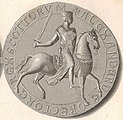
|
1214-1249 | Lion rampant on saddle and shield.
|
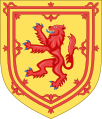
|
Before 1558 | A red lion, rampant, on a yellow field within a double royal tressure, flory counter-flory. |

|
1558 | Mary, Queen of Scots, Dauphine of France, impaled with arms of Francis, Dauphin of France.[10] |
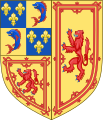
|
1558–1559 | King consort of Scots.[10]
|

|
1559 | King consort of Scots, both halves incorporating the claim to the English throne made for a short time.[11]
|
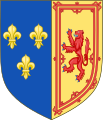
|
1559–1560 | Mary, Queen of Scots and France[10]
|
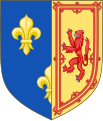
|
1560–1565 | Mary, Queen of Scots and Queen dowager of France.[10] |

|
1565–1603 | Upon her second marriage to King James VI was the last monarch of Scotland to use these arms before the Union of the Crowns in 1603.
|
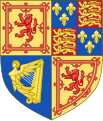 |
1603–1652
1660-1689 |
James VI quarted the Scottish arms with those of the kingdoms of England and Ireland after inheriting both in 1603. The arms were not used during the Commonwealth or the Protectorate, which existed in Scotland from 1654 to 1660 and during which the monarchy was abolished. |
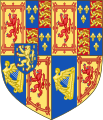 |
1689–1694 | In 1689 Mary II and her husband William III, who ruled as co-monarchs. They impaled their arms, which were identical except that William bore the arms with an inescutcheon of Nassau , the royal house to which he belonged: Azure billetty or, a lion rampant of the last armed and langued gules.
|
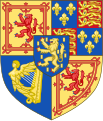 |
1694–1702 | After Mary II's death, William III used his arms alone. |
 |
1702–1707 | Anne used the 1603 version of the arms until the creation of the Kingdom of Great Britain in 1707. |
As a banner
Since the formation of the
Current uses

The royal arms in their current form were adopted on the accession of
The arms of the
The coat of arms of the Government of Gibraltar correspond to the British royal arms in that they also feature the Scottish arms in the second quarter of the shield and use the unicorn as the sinister supporter, with the Gibraltar's own coat of arms under the motto Dieu et mon droit.
The
Both the
The royal tressure appears on the arms of numerous Scottish families and institutions as a mark of royal favour, known in heraldry as an
The arms of the Archdiocese of Mechelen used to be the same as those of Scotland. They were quartered with the
The coat of arms of the town of Sankt Wendel in Saarland combines elements of the Scottish flag and the Scottish coat of arms. Four lilies, taken from the Scottish royal coat of arms, on a blue background, are reminiscent of Saint Wendelin. Legendary tradition describes him as a Scottish king's son. In 1465, the parish of St. Wendel sent two parishioners to Scotland to research the legend of Saint Wendelin's royal Scottish origins. After allegedly positive confirmation, the Scottish lion coat of arms was used in the seal of the parish of St. Wendel. The blue-silver/white flag of Sankt Wendel takes up the blue background of the coat of arms of the city and the silver/white of its lilies as well as the colors of the Scottish flag.[14][15][16][17]
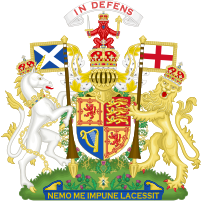 |
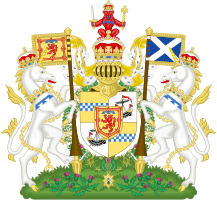 |
 |
 |
 |
|---|---|---|---|---|
Arms of King Charles III used in Scotland |
Arms of Prince William, Duke of Rothesay used in Scotland
|
Province of Nova Scotia |
Arms of the
Archdiocese of Mechelen-Brussels |
See also
References
- ^ "The 9 bizarre laws that still exist in Scotland – and you've probably already broken some". 28 September 2020.
- ISBN 978-1-4717-5093-9.
- ^ McWilliam, John (March 2018). "The Royal Arms of Scotland". The Heraldry Society.
- ^ Fox-Davies, Charles (1915). The Book of Public Arms. p. 712.
- ^ "Scottish Coins". www.predecimal.com. Archived from the original on 24 September 2015.
- ^ "Scottish Coins ~ Mary (1542–1567)". Archived from the original on 2 October 2010. Retrieved 30 September 2010.
- ISBN 9780853239376– via Google Books.
- ^ "British Monarchy web site". Archived from the original on 22 November 2008. Retrieved 11 August 2008.
- ISBN 0-9525258-2-8)
- ^ a b c d "The Franco-Scots Coinage of Mary Stuart and Francis II". Archived from the original on 26 February 2008.
- ^ Elizabeth and Mary, Royal Cousins, Rival Queens: Curators' Picks, British Library, 8 October 2021
- ^ "Yahoo | Mail, Weather, Search, Politics, News, Finance, Sports & Videos". www.yahoo.com.
- ^ "Archdiocese of Mechelen-Brussel - Arms, armoiries, escudo, wappen, crest of Archdiocese of Mechelen-Brussel". www.heraldry-wiki.com. Retrieved 16 December 2019.
- ^ Kurt Hoppstädter: Die Wappen des Saarlandes, I. Teil, Hrsg.: Historischer Verein für das Saarland e. V. in Zusammenarbeit mit dem Landesarchiv der Regierung des Saarlandes (Zeitschrift für saarländische Heimatkunde, 3. Jg., Heft 1–4), Saarbrücken 1953, S. 87–88.
- ^ Hermann Lehne, Horst Kohler: Wappen des Saarlandes, Landes- und Kommunalwappen, Saarbrücken 1981, S. 216–217.
- ^ Stadt St. Wendel, Webseite: Stadtwappen/-signet. Abruf am 17. Februar 2021.
- ^ Walter Hannig: in: Karl Schwingel (Hrsg.): Festschrift für Karl Lohmeyer, im Auftrag des Ministeriums für Kultus, Unterricht und Volksbildung herausgegeben, Saarbrücken 1954, S. 268ff.
External links
 Media related to Royal coats of arms of Scotland at Wikimedia Commons
Media related to Royal coats of arms of Scotland at Wikimedia Commons




